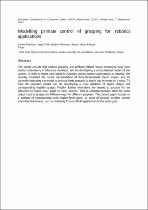JavaScript is disabled for your browser. Some features of this site may not work without it.
- ResearchSpace
- →
- Research Publications/Outputs
- →
- Conference Publications
- →
- View Item
| dc.contributor.author |
Kleinhans, A

|
|
| dc.contributor.author |
Thill, S

|
|
| dc.contributor.author |
Rosman, Benjamin S

|
|
| dc.contributor.author |
Detry, R

|
|
| dc.contributor.author |
Tripp, B

|
|
| dc.date.accessioned | 2015-08-19T11:14:14Z | |
| dc.date.available | 2015-08-19T11:14:14Z | |
| dc.date.issued | 2014-09 | |
| dc.identifier.citation | Kleinhans, A, Thill, S, Rosman, B.S., Detry, R and Tripp, B. 2014. Modelling primate control of grasping for robotics applications. In: European Conference on Computer Vision (ECCV) Workshops, Zurich, Switzerland, 7 September 2014 | en_US |
| dc.identifier.uri | http://link.springer.com/chapter/10.1007%2F978-3-319-16181-5_33 | |
| dc.identifier.uri | http://hdl.handle.net/10204/8099 | |
| dc.description | European Conference on Computer Vision (ECCV) Workshops, Zurich, Switzerland, 7 September 2014. Due to copyright restrictions, the attached PDF file only contains the abstract of the full text item. For access to the full text item, please consult the publisher's website. | en_US |
| dc.description.abstract | The neural circuits that control grasping and perform related visual processing have been studied extensively in Macaque monkeys. We are developing a computational model of this system, in order to better understand its function, and to explore applications to robotics. We recently modelled the neural representation of three-dimensional object shapes, and are currently extending the model to produce hand postures so that it can be tested on a robot. To train the extended model, we are developing a large database of object shapes and corresponding feasible grasps. Finally, further extensions are needed to account for the influence of higher-level goals on hand posture. This is essential because often the same object must be grasped in different ways for different purposes. The present paper focuses on a method of incorporating such higher-level goals. A proof-of-concept exhibits several important behaviours, such as choosing from multiple approaches to the same goal. | en_US |
| dc.language.iso | en | en_US |
| dc.publisher | IEEE | en_US |
| dc.relation.ispartofseries | Workflow;14364 | |
| dc.subject | Grasping | en_US |
| dc.subject | Affordances | en_US |
| dc.subject | Macaque monkeys | en_US |
| dc.subject | Robotics | en_US |
| dc.subject | Anterior intraparietal areas | en_US |
| dc.subject | AIP | en_US |
| dc.title | Modelling primate control of grasping for robotics applications | en_US |
| dc.type | Conference Presentation | en_US |
| dc.identifier.apacitation | Kleinhans, A., Thill, S., Rosman, B. S., Detry, R., & Tripp, B. (2014). Modelling primate control of grasping for robotics applications. IEEE. http://hdl.handle.net/10204/8099 | en_ZA |
| dc.identifier.chicagocitation | Kleinhans, A, S Thill, Benjamin S Rosman, R Detry, and B Tripp. "Modelling primate control of grasping for robotics applications." (2014): http://hdl.handle.net/10204/8099 | en_ZA |
| dc.identifier.vancouvercitation | Kleinhans A, Thill S, Rosman BS, Detry R, Tripp B, Modelling primate control of grasping for robotics applications; IEEE; 2014. http://hdl.handle.net/10204/8099 . | en_ZA |
| dc.identifier.ris | TY - Conference Presentation AU - Kleinhans, A AU - Thill, S AU - Rosman, Benjamin S AU - Detry, R AU - Tripp, B AB - The neural circuits that control grasping and perform related visual processing have been studied extensively in Macaque monkeys. We are developing a computational model of this system, in order to better understand its function, and to explore applications to robotics. We recently modelled the neural representation of three-dimensional object shapes, and are currently extending the model to produce hand postures so that it can be tested on a robot. To train the extended model, we are developing a large database of object shapes and corresponding feasible grasps. Finally, further extensions are needed to account for the influence of higher-level goals on hand posture. This is essential because often the same object must be grasped in different ways for different purposes. The present paper focuses on a method of incorporating such higher-level goals. A proof-of-concept exhibits several important behaviours, such as choosing from multiple approaches to the same goal. DA - 2014-09 DB - ResearchSpace DP - CSIR KW - Grasping KW - Affordances KW - Macaque monkeys KW - Robotics KW - Anterior intraparietal areas KW - AIP LK - https://researchspace.csir.co.za PY - 2014 T1 - Modelling primate control of grasping for robotics applications TI - Modelling primate control of grasping for robotics applications UR - http://hdl.handle.net/10204/8099 ER - | en_ZA |






